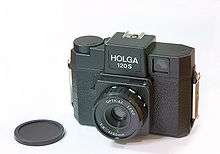Toy camera
Within the field of photography, a toy camera is a simple, inexpensive film camera.


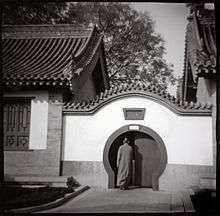
Despite the name, they are in fact always fully functional and capable of taking photographs, albeit with optical aberrations due to the limitations of the simple lenses. From the 1990s onward there has been interest in the artistic use of such cameras, both those designed for children such as the Diana, and others originally intended as mass-market consumer cameras such as the Lomo LC-A, Lubitel, and Holga.
Many professional photographers have used toy cameras and exploited the vignetting, blur, light leaks, and other distortions of their inexpensive lenses for artistic effect to take award-winning pictures.[1] Toy camera photography has been widely exhibited at many popular art shows, such as the annual "Krappy Kamera" show at the Soho Photo Gallery in the Tribeca neighborhood of New York City. Various publications such as Popular Photography magazine have extolled the virtues of the Diana camera in its own right as an "art" producing image maker. Several books have also featured the work of toy cameras, such as The Friends of Photography's The Diana Show, Iowa by Nancy Rexroth, and Angels at the Arno by Eric Lindbloom.
Lomography
Lomography is a genre of photography, involving taking spontaneous photographs with minimal attention to technical details. Lomographic images often exploit unpredictable non-standard optical traits of cheap toy camera (such as light leaks and irregular lens alignment), and non-standard film processing techniques, for aesthetic effect.[2][3] Similar-looking techniques with digital photography, often involving "lomo" image postprocessing filters, may also be considered lomographic.[4] The lomography trend peaked in 2011.[2]
While cheap plastic toy cameras using film were and are produced by multiple manufactuers, lomography is named after the Soviet-era cameras produced by the "Leningradskoye Optiko-Mekhanicheskoye Obyedinenie.
Lomography has been a highly social pursuit, with local clubs organized by The Lomographic Society International (Lomographische AG, a commercial company selling lomo cameras).[3] The company promotes the genre; however, it is not necessary to use the company's products to take lomographic photos.[4]
"Lomography" is claimed as a commercial trademark of Lomographische AG, which their creators associate to a photographic image style and a film camera movement and community facilitated by The Lomographic Society International. However, it has become a genericized trademark; most camera phone photo editor apps include a "lomo" filter.[4]
History
The lomography name is inspired by the former state-run optics manufacturer LOMO PLC of Saint Petersburg, Russia that created and produced the 35 mm LOMO LC-A Compact Automat camera, now central to lomography. This camera was loosely based upon the Cosina CX-1 and introduced in the early 1980s.[5] The LOMO LC-A produces "unique, colorful, and sometimes blurry" images.[6]

The Lomographic Society International was founded in 1992 by a group of Viennese students interested in the LCA, a camera created by LOMO PLC of Saint Petersburg, Russia.[7][8][9] Lomography started as an art movement through which the students put on exhibitions of photos; the art movement then developed into the Lomographische AG, a commercial enterprise.
Lomographische AG
Lomographische AG is a commercial company headquartered in Vienna, Austria, which sells cameras, accessories, and film.[3]
Lomographische AG signed an exclusive distribution agreement with LOMO PLC in 1995 — becoming the sole distributor of all LOMO LC-A cameras outside of the former Soviet Union.[10] The new company reached an agreement with the deputy mayor of St Petersburg, the future Russian Prime Minister and President, Vladimir Putin, to receive a tax break in order to keep the LOMO factory in the city open.[3]
Since the introduction of the original LOMO LC-A, Lomographische AG has produced a line of their own film cameras. In 2005, production of the original LOMO LC-A was discontinued. Its replacement, the LOMO LC-A+, was introduced in 2006. The new camera, made in China rather than Russia, featured the original Russian lens manufactured by LOMO PLC.[11] This changed as of mid-2007 with the lens now made in China as well. In 2012 the LC-A+ camera was re-released as a special edition.[12] It costs ten times the original secondhand value of the old LOMO LC-A.[3]
The Lomographic Society International (Lomographische AG) has moved into producing their own range of analog cameras, films and accessories. Lomographische AG has also released products catered to digital devices, such as the Smartphone Film Scanner;[13] and the Achromat lens collection[14] for SLR cameras with Canon EF, Nikon F or Pentax K mounts, inspired by 19th century Daguerreotype photography. In 2013, together with Zenit, Lomographische AG produced a new version of the Petzval Lens designed to work with Canon EF and Nikon F mount SLR cameras.
Some have questioned the pricing of Lomographische AG's cheaply-made plastic "toy" cameras,[15] which run from $100[15] to $400 US.[3]
Models
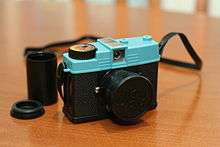
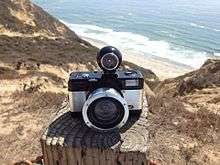
Cameras that have been marketed by Lomographische AG:
- LOMO LC-A+[3]
- LC-A 120[16][17]
- Diana F+[7]
- Spinner 360°
- Sprocket Rocket
- Actionsampler
- Pop-9
- Oktomat
- Fisheye
- Fisheye 2
- Colorsplash
- Colorsplash Flash
- SuperSampler
- La Sardina
- LomoKino – a 35 mm analog movie camera
- Diana Baby – 110 film
- Fisheye Baby – 110 film
- Konstruktor – a build-it-yourself 35 mm SLR camera
- Fritz the Blitz
Film
The company produces several kinds of 35 mm, 120 and 110 film.
Photo gallery
 A Fisheye 2 with a fisheye viewfinder
A Fisheye 2 with a fisheye viewfinder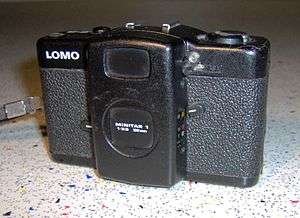 A 1988 LOMO LC-A camera
A 1988 LOMO LC-A camera Fisheye-lens photo of Wakayama Castle
Fisheye-lens photo of Wakayama Castle The view of buildings in Downtown Los Angeles through the Fisheye 2 camera.
The view of buildings in Downtown Los Angeles through the Fisheye 2 camera.
See also
| Wikimedia Commons has media related to Toy cameras. |
- Holga, Chinese mass-market 120 film camera
- Lubitel, mass-market Russian, 120 film, twin-lens reflex cameras
- Lensbaby
References
- Schiesel, Seth (8 June 2005). "Which Camera Does This Pro Use? It Depends on the Shot". The New York Times. Retrieved 4 May 2010.
- "What is Lomography or lomo camera?". The Darkroom Photo Lab. 11 February 2016.
- Blenford, Adam (22 September 2007). "Lomos: New take on an old classic". BBC News. Retrieved 26 May 2012.
- Watterson, Derek. "Holga Cameras and Lomography". Photography Course.
- "LOMO LC-A's Father: The Cosina CX-2". Lomographische AG. 2 August 2011. Retrieved 26 May 2012.
- Drake, James (12 June 2000). "A Camera That Really Opens Your Eyes". Bloomberg Businessweek. Retrieved 26 May 2012.
- "How An Analog Photo Company Can Thrive In An Instagram Age". Fast Company. 11 August 2015. Retrieved 2018-05-10.
- Dowling, Stephen (22 November 2012). "Did the Lomo camera save film photography?". BBC News. Retrieved 2018-05-10 – via www.bbc.co.uk.
- "History · Lomography". Lomographische AG.
- "A guide to Lomography". ePhotozine. 2 August 2002. Retrieved 26 May 2012.
- "Timeline". Lomographische AG. Retrieved 30 May 2012.
- "Lomography LC-A+ 20th Anniversary Edition". Hypebeast. Retrieved 2017-03-22.
- "The Lomography Smartphone Film Scanner". Hypebeast. Retrieved 2017-03-22.
- "Lomography Bridges Technology With the Past by Recreating the First Photographic Optic Lens". HYPEBEAST. Retrieved 2017-03-22.
- "Opinion: Lomography, an Alternative Perspective on Traditional Photo Standards". petapixel.com.
- "Film is not dead! The Lomo LC-A 120 helps fuel the retro revival". TechRadar. Retrieved 2018-05-10.
- "Lomography LC-A 120". PCMag UK. 7 May 2015. Retrieved 2018-05-10.
External links
- Lomography and the ‘Analogue Future’, Time, 2012
